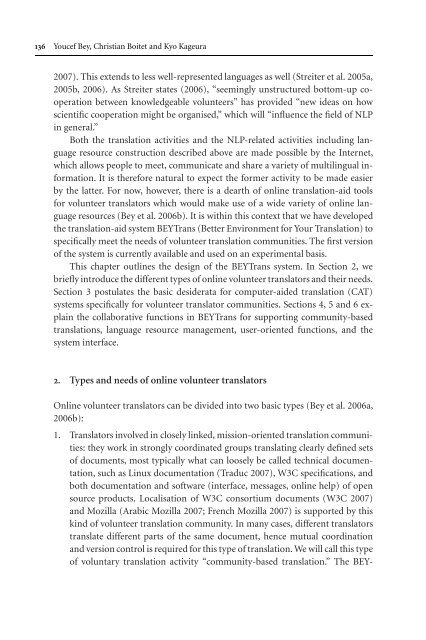Topics in Language Resources for Translation ... - ymerleksi - home
Topics in Language Resources for Translation ... - ymerleksi - home
Topics in Language Resources for Translation ... - ymerleksi - home
- No tags were found...
Create successful ePaper yourself
Turn your PDF publications into a flip-book with our unique Google optimized e-Paper software.
136 Youcef Bey, Christian Boitet and Kyo Kageura2007). This extends to less well-represented languages as well (Streiter et al. 2005a,2005b, 2006). As Streiter states (2006), “seem<strong>in</strong>gly unstructured bottom-up cooperationbetween knowledgeable volunteers” has provided “new ideas on howscientific cooperation might be organised,” which will “<strong>in</strong>fluence the field of NLP<strong>in</strong> general.”Both the translation activities and the NLP-related activities <strong>in</strong>clud<strong>in</strong>g languageresource construction described above are made possible by the Internet,which allows people to meet, communicate and share a variety of multil<strong>in</strong>gual <strong>in</strong><strong>for</strong>mation.It is there<strong>for</strong>e natural to expect the <strong>for</strong>mer activity to be made easierby the latter. For now, however, there is a dearth of onl<strong>in</strong>e translation-aid tools<strong>for</strong> volunteer translators which would make use of a wide variety of onl<strong>in</strong>e languageresources (Bey et al. 2006b). It is with<strong>in</strong> this context that we have developedthe translation-aid system BEYTrans (Better Environment <strong>for</strong> Your <strong>Translation</strong>) tospecifically meet the needs of volunteer translation communities. The first versionof the system is currently available and used on an experimental basis.This chapter outl<strong>in</strong>es the design of the BEYTrans system. In Section 2, webriefly <strong>in</strong>troduce the different types of onl<strong>in</strong>e volunteer translators and their needs.Section 3 postulates the basic desiderata <strong>for</strong> computer-aided translation (CAT)systems specifically <strong>for</strong> volunteer translator communities. Sections 4, 5 and 6 expla<strong>in</strong>the collaborative functions <strong>in</strong> BEYTrans <strong>for</strong> support<strong>in</strong>g community-basedtranslations, language resource management, user-oriented functions, and thesystem <strong>in</strong>terface.2. Types and needs of onl<strong>in</strong>e volunteer translatorsOnl<strong>in</strong>e volunteer translators can be divided <strong>in</strong>to two basic types (Bey et al. 2006a,2006b):1. Translators <strong>in</strong>volved <strong>in</strong> closely l<strong>in</strong>ked, mission-oriented translation communities:they work <strong>in</strong> strongly coord<strong>in</strong>ated groups translat<strong>in</strong>g clearly def<strong>in</strong>ed setsof documents, most typically what can loosely be called technical documentation,such as L<strong>in</strong>ux documentation (Traduc 2007), W3C specifications, andboth documentation and software (<strong>in</strong>terface, messages, onl<strong>in</strong>e help) of opensource products. Localisation of W3C consortium documents (W3C 2007)and Mozilla (Arabic Mozilla 2007; French Mozilla 2007) is supported by thisk<strong>in</strong>d of volunteer translation community. In many cases, different translatorstranslate different parts of the same document, hence mutual coord<strong>in</strong>ationand version control is required <strong>for</strong> this type of translation. We will call this typeof voluntary translation activity “community-based translation.” The BEY-
















